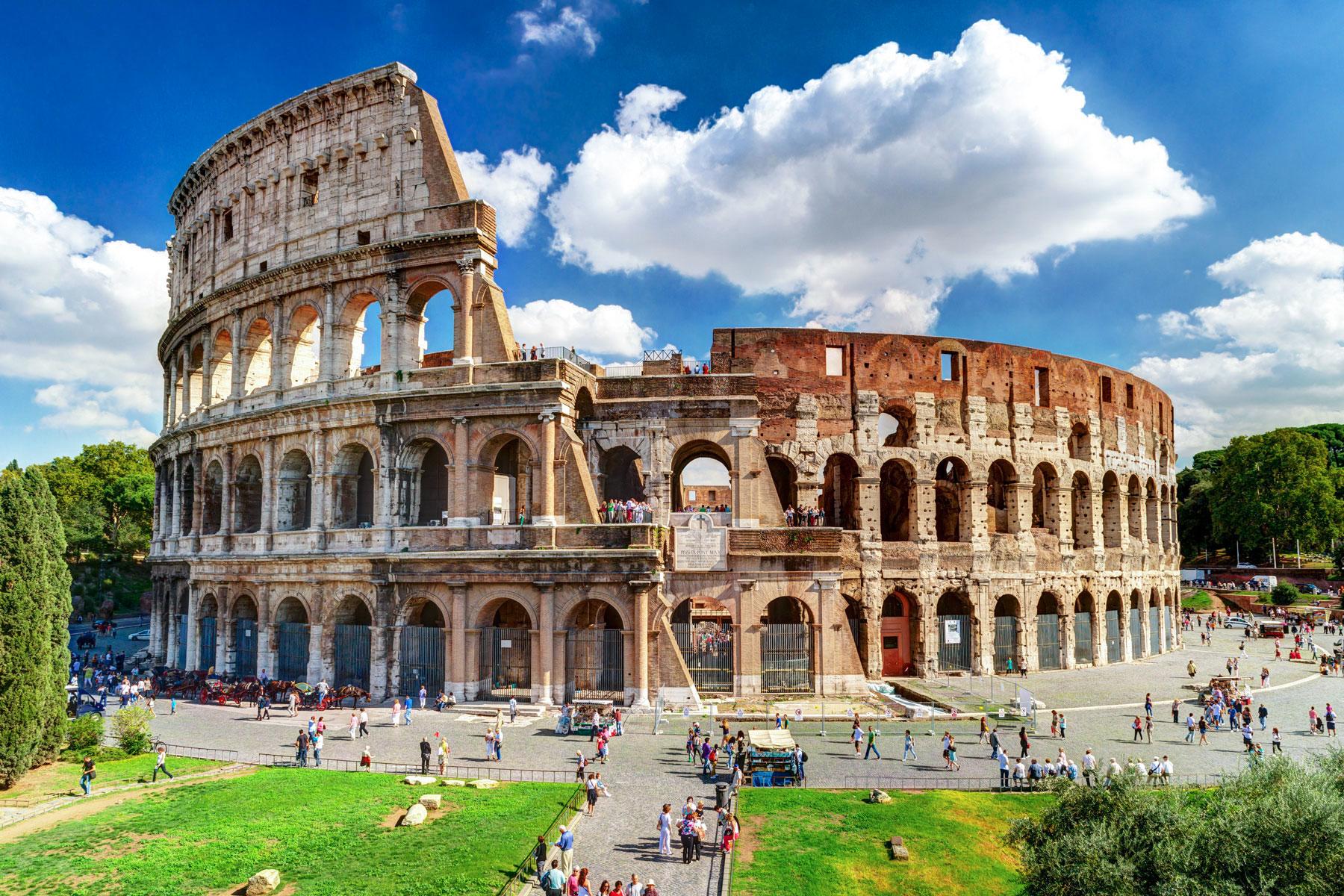Before traveling to antiquity's most famous (and massive) amphitheater, here’s what you need to understand about Europe’s only entry on the “Seven Wonders of The World” list.
More than any other attraction, The Colosseum is probably at the top of most people’s European sightseeing list. The reason is threefold. Its appealing architecture still stands after nearly 2,000 years. It’s a rousing relic people used to consider family-friendly entertainment (i.e. killing humans for sport). And it’s located in the heart of Rome, aka “the former capital of the world” and one of the most beloved, compelling, and oldest cities on the continent. That said, here’s what you should consider before planning a visit.
Is It Really Worth It?
Yes. Although you’ll be hard pressed to find much solace or elbow room here, there’s a high chance you’ll gain newfound perspective after visiting. Just looking at the six-acre, 150-foot tall structure from the outside is a stop-you-in-your-tracks experience. And learning about the how, when, and why while inside is just as enlightening, even for non-history buffs.
How Do I Get There?
Flying into Leonardo da Vinci International Airport (FCO) is likely the most convenient starting point for those crossing entire oceans or continents. From there it’s about a 25-minute cab (or one-hour public transport) ride northeast to the Colosseum. Those arriving from mainland Europe or other parts of the city can do so with a combination of trains and/or subway connections to the Colosseo Metro Station.
INSIDER TIPIf approaching on foot or by car, you’ll get a wonderfully sudden first-look at The Colosseum from Via degli Annibaldi (southbound).
Recommended Fodor’s Video
Why Is It Such a Big Deal?
If ancient history had a Super Bowl, this would be it. Built in AD 80 at the height of the Roman Empire, the Colosseum hosted up to 70,000 people at a time for deathly gladiator fights, hunting exhibitions, and public executions. Admission and food were free, and the party lasted for four centuries until the fall of Rome.
Today, the Colosseum is widely regarded as one of the “Seven Wonders of the World” and the only one in Europe. Although few things in life are truly “must-see”—because different people value different things—this enduring and well-maintained edifice is a notable and powerful exception.
How Crowded Is It?
Very. Given its glowing popularity and reputation, The Colosseum welcomes an estimated six million visitors per year, mostly during June, July, and August. But it never feels like you don’t have any personal space while visiting, even in summer. Like the nearby St. Peter’s Basilica, the amphitheater’s gargantuan size can more than accommodate the heavy crowds. What’s more, there are several tricks for avoiding long lines and cattle-like waiting times, as detailed below.
When's the Best Time to Visit?
To avoid the infamous summer heat and crowds, plan your visit anytime between November through February. From March until October, the building and surrounding grounds are almost always overrun, especially in peak summer months. If visiting then, you can avoid some of the crowds by visiting immediately upon opening at 8:30 am, or late in the afternoon, about one to two hours before closing (4 pm in the off-season, 7 pm in the summer).
INSIDER TIPIf visiting in summer, avoid midday as there is no shade or respite from the heat. For ideal lighting, plus fewer crowds, consider visiting in the evening before sundown.
How Do I Get Tickets?
To avoid the sometimes hours-long wait times in person, it’s highly recommended that you buy your tickets in advance for $14 each from the official ticket office and/or hire a guide who will get you through the entrance in the shortest amount of time. Either way, kids under 18 are free and EU students and teachers get discounted rates. If in-person is your only option, consider buying tickets at the Roman Forum ticket office or visiting 1-2 hours before closing when lines are shorter.
NOTE: Entrance into The Colosseum also includes admission into the surrounding Palatine Hill and Roman Forum, each of which features romantic outdoor ruins of important ancient buildings and excellent views of The Colosseum’s exterior.
Do I Need a Guide?
No. But doing so will help you save time, avoid more crowds, and better appreciate the context and significance of what you’re visiting. In that sense, a group or private guide comes highly recommended. To that end, consider booking either the well-rated “Skip the line” Group Tour or “Skip the line” Private Tour for Families from GetYourGuide, which is a booking platform for travel experiences in Europe.
How Do Popular "Skip the Line" Tours Work?
As you’ll quickly learn from other Rome attractions, “skip the line” tours are just as good as they sound, but not quite as exclusive or VIP as you’d think. What they really are is advance online reservations (either by yourself or when booked by a guide) that let you bypass the extremely long ticket office lines. With “skip the line,” you’re still required to sort through security lines for several minutes and you won’t get “backstage” access. But it’s a glorious no-brainer, if not the only way to get the most from your Colosseum visit.
Are the Add-on Tours Worth It?
Yes. When visiting The Colosseum, you’ll also have the chance to explore the impressive Roman Forum and Palatine Hill that surround the arena. Both areas are included with standard admission and independently worth visiting, especially the Forum. Take the chance.
For $14 more (kids under 18 remain free), you are granted exclusive access to The Colosseum’s underground and third floor levels, which offer even greater depth and impressive views of the magnificent amphitheater. Both are also highly rated.
How Can I Reduce My Exposure to Crowds?
As detailed above, any combination of the following will help you better enjoy The Colosseum: buy your tickets in advance online—either by yourself or through a guide. Hire a guide who can help you move through the grounds in the best, most-crowd free, and efficient way. And visit during off-peak season (November-February) and times of day (any day within two hours of opening or closing). Although crowds are never completely avoided, they can be managed with a little advance planning.
How Much Time Should I Spend There?
Anywhere between one half-day, one full day, or even maybe two days, depending on your enthusiasm for ancient history. With the surrounding Palatine Hills, Roman Forum, and additional underground and third floor tours, there’s a lot more to do than simply walking around a really old amphitheater.
As for the ideal itinerary, the verdict is split: some prefer seeing the Colosseum first, followed by Palatine and then finish at Roman Forum, while others prefer to descend from Palatine Hill and into the Forum before finishing at The Colosseum.
What's the Best Thing to Do While There?
Before rushing in to explore the building’s interior, take the time to appreciate the exterior. Although just one-third of the structure remains (because damaging earthquakes and looting barbarians), it is an architectural marvel worth pausing for. Once inside, look up to see how restorators are cleaning the soot off the ceilings. Then examine the exposed arena and try to imagine what a madhouse it must have been when a celebrity gladiator entered the stage or claimed a victory.
From the second floor, head southwest to the viewing platform for a wonderful glimpse of the Arch of Constantine. If you’re finishing up at the Forum, take it all in from Via del Fori Imperiali, while listening to street performers as the sun sets on this reverent place.
Where Can I Get the Best Photo?
Like all good stadiums, there’s really not a bad seat in The Colosseum. Impressive photos of the exterior’s elliptical shape can be taken from all angles. But you can get a better vantage point from Parco Del Colle Oppio to the north, Palatine Hill to the southwest, or just outside the main entrance. If you can, reach for your camera at either sunrise or sunset. Admittedly, interior photos are a bit of a mess (although the history is better from the inside). Either way, it’s best to focus your lens from the outside.
Is It Wheelchair Accessible and/or Physically Demanding?
Yes and no. The Colosseum has a step-free main entrance, flat smooth interior, and elevator to the upper levels for the physically impaired. While the included Roman Forum and Palatine Hill are also wheelchair accessible, they reportedly aren’t as good as The Colosseum. As for being physically demanding, adults and children in moderate to good health should have no difficulty exploring the grounds and cobblestone stairs.
Where Should I Spend the Night?
Although The Colosseum is smack dab in the middle of town, nearly all of the other top-rated sites—including The Vatican, plazas, fountains, parks, food, and shops—tend to cluster nearer the northwest side of the city. That being the case, the Marriott’s Le Méridien Visconti Rome couldn’t be more perfectly situated in a quiet and beautiful part of town within 15-20 minutes walking distance to just about everything you’d want to see. The rooms are modern and relaxing, the rates affordable, and the free breakfast buffet is one for the ages.
What Else Should I Consider Seeing Nearby?
In the immediate vicinity, not much. Neither the food nor gelato is particularly good—when visiting The Colosseum, it’s really about the view and history. In wider Rome, however, it makes sense to pair your visit with a focus on the northwest side of the city toward St. Peter’s ginormous Basilica, The Vatican’s captivating Museums, the Sistine Chapel’s surreal surroundings, renting a quadricycle in Villa Borghese, people watching in Piazzas Navona and del Popolo, and seeing (and wondering) if The Pantheon’s ceiling is real or fake.




